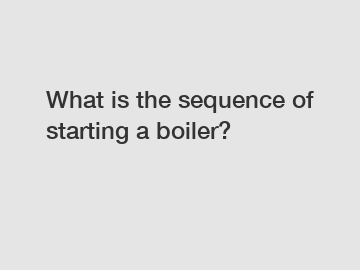What is the sequence of starting a boiler?
Boilers play a crucial role in providing heat and warmth to homes and businesses. They are designed to efficiently convert water into steam or hot water, which can then be used for various purposes such as heating buildings, providing hot water for bathing, cooking, and more. However, starting a boiler is not as simple as flipping a switch. It requires a specific sequence of steps to ensure safe and effective operation. In this article, we will discuss the sequence of starting a boiler in detail.
1. Preparing the boiler for ignition.
Before starting a boiler, it is essential to perform a few preliminary checks to ensure everything is in order. These include checking the water level in the boiler, inspecting the valves and fittings for any leaks or damage, ensuring the fuel supply is sufficient, and verifying that all safety devices are in proper working condition. These steps are crucial to ensure the safety of both the occupants and the boiler itself.

2. Turning on the power.
Once the preliminary checks are complete, the next step is to turn on the power to the boiler. This involves ensuring that the main power switch is in the "off" position, then gradually increasing the power until the boiler is operational. It is important to follow the manufacturer's instructions regarding power supply to prevent any damage to the boiler and its components.
3. Lighting the pilot light.
The pilot light is a small flame that ignites the main burner of the boiler. To light the pilot light, locate the pilot valve and turn it to the "pilot" position. Press and hold the pilot knob while simultaneously lighting the pilot flame with a match or a lighter. Keep holding the knob for about 30 seconds to a minute to allow the pilot flame to stabilize before releasing it.
4. Igniting the main burner.
Once the pilot light is lit and stable, it is time to ignite the main burner. Turn the pilot valve to the "on" position, and the burner should start firing up. If the boiler has an automatic ignition system, simply pressing the "ignite" button should do the job. However, for boilers without an automatic ignition system, follow the manufacturer's instructions for manually lighting the burner.
5. Monitoring the boiler.
After the burner is ignited, it is crucial to closely monitor the boiler's operation. Keep an eye on the gauges to ensure the proper temperature and pressure levels are maintained. Watch for any unusual noises, smells, or leaks, as these may indicate a problem with the boiler.
In conclusion, starting a boiler requires a specific sequence of steps to ensure safe and efficient operation. By following the steps outlined above, you can start your boiler with confidence. However, it is essential to note that the sequence may vary depending on the type and model of the boiler. Always consult the manufacturer's instructions for your specific boiler model.
If you have any further questions or need assistance with starting your boiler, please do not hesitate to contact us. Our team of experts is here to help you ensure the safe and efficient operation of your boiler.
If you are looking for more details, kindly visit Natural Gas Hot Water Condensing Boiler, Best Coke Oven Exhaust Recovery Boiler, Natural Gas Hot Water Condensing Boiler.
55
0
0

Comments
All Comments (0)